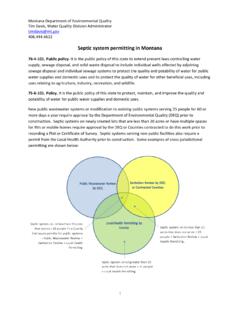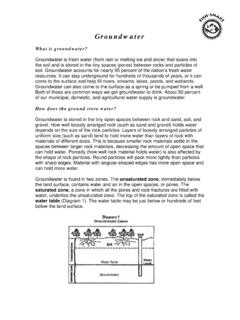Transcription of Inherent Factors Affecting Soil EC - USDA
1 Page 1 Guides for Educators soil electrical conductivity (EC) is a measure of the amount of salts in soil (salinity of soil ). It is an important indicator of soil health. It affects crop yields, crop suitability, plant nutrient availability, and activity of soil microorganisms which influence key soil processes including the emission of greenhouse gases such as nitrogen oxides, methane, and carbon dioxide. Excess salts hinder plant growth by Affecting the soil -water balance. Soils containing excess salts occur naturally in arid and semiarid climates. Salt levels can increase as a result of cropping, irrigation, and land management. Although EC does not provide a direct measurement of specific ions or salt compounds, it has been correlated to concentrations of nitrates, potassium, sodium, chloride, sulfate, and ammonia.
2 For certain non-saline soils, determining EC can be a convenient and economical way to estimate the amount of nitrogen (N) available for plant growth. Inherent Factors Affecting soil EC Inherent Factors Affecting EC include soil minerals, climate, and soil texture which cannot be changed. Salts originate from disintegration (weathering) of minerals and rocks. In areas with high amounts of rainfall, soluble salts from minerals and rocks are flushed below the root zone, eventually into deep groundwater systems or into streams that transport salts to the ocean. Conversely, in arid areas or in areas where less rainfall occurs or saline irrigation water is used, soluble salts are more likely to accumulate and remain near the soil surface, resulting in high EC. Salt-affected soils mainly occur in the western United States; in arid or semiarid areas where annual rainfall is low.
3 Because salts move with water; low areas, depressions or other wet areas where water accumulates tend to be higher in EC than surrounding higher-lying, better drained areas. Clay soils dominated by clay minerals that have a high cation-exchange capacity (CEC), such as smectite, have higher EC than clay soils dominated by clay minerals that have a low CEC, such as kaolinite. Soils with restrictive layers, such as claypans, typically have higher EC because salts cannot be leached from the root zone and accumulate on the surface. Infiltration water can also interact with underlying bedrock that weathers releasing salts which creates saline seeps where it exits. Salinity ManagementSoil EC is affected by cropping, irrigation, land use, and application of fertilizer, manure, and compost. When managing for salinity on irrigated land, irrigation water salinity must also be measured.
4 Irrigating in amounts too low to leach salts, or with water high in salts, allows salts to accumulate in the root zone, increasing EC. Existing salinity levels and amount of salt contained in manure and municipal waste need to be closely monitored to prevent salinity problems, especially in arid climates. Nitrogen fertilizer application can increase salinity and should be monitored closely, especially on sites with potential salinity concerns. Page 2 Guides for Educators soil Electrical Conductivity soil Quality Kit usda -NRCS Management that leads to low organic matter, poor infiltration, poor drainage, saturated soil , or compaction can increase EC and the soil s ability to buffer EC. When irrigating, additional water beyond crop needs can be used to flush excessive salts below the root zone and maintain a EC level, which is based on crop tolerance.
5 Care is needed when applying extra water to leach salts because soils can become waterlogged, allowing salts to accumulate. Leaving crop residue on the surface limits evaporation, and retains soil moisture allowing rainfall and irrigation to be more effective in leaching salts. In some cases, a combination of irrigation, and drainage is necessary to reduce salinity. Good soil management measures to maintain soil organic matter and overall soil health, must be utilized to maintain the desired EC level. Problems Related to EC and Relationship of EC to soil Function Electrical conductivity levels can serve as an indirect indicator of the amount of water and water-soluble nutrients available for plant uptake such as nitrate-N. Areas of saline soils need to be identified and managed differently from areas of non-saline soils.
6 soil microorganism activity declines as EC increases. This impacts important soil processes such as respiration, residue decomposition, nitrification, and denitrification (Table 1). Soils with a high concentration of sodium salts (sodic conditions) have additional problems, such as poor soil structure, poor infiltration or drainage, and toxicity for many crops. Each crop has a salt tolerance. Table 3 shows the percent yield reduction based on the soil EC levels. EC1:1 readings less than 1 dS/m, soil are considered non-saline (Table 2) and do not impact most crops and soil microbial processes (Tables 1 and 3). EC1:1 readings greater than 1 dS/m, are considered saline and impact important microbial processes, such as nitrogen cycling, production of nitrous and other N oxide gases, respiration, and decomposition; populations of plant-parasitic nematodes can increase; and increased nitrogen losses.
7 Even slight to moderate salinity can impede crop growth as shown in Figure 1. Figure 1. EC1:1 values using compost and tap water for tomatoes (Gage, 2012). * EC1:1 values of compost adjusted for well water EC values of dS/m to values for distilled water are shown as footnoted values below each pot in Figure 1. Compost EC1:1 readings were adjusted as follows: distilled water = Compost EC1:1 in well water (EC of well water / Compost EC1:1 with well water) = (1 ) = (.385) = dS/m. *EC1:1 *EC1:1 *EC1:1 Page 3 Guides for Educators soil Electrical Conductivity soil Quality Kit usda -NRCS Table 1. soil EC influence on microbial processes and gaseous N production in soils amended with sodium chloride (NaCl) or nitrogen fertilizers (after Smith and Doran, 1996 (Tables 10-5 & 10-6) and Adviento-Borbe et al., 2006). Process EC1:1 Range (dS/m) Relative Decrease/Increase (%) Threshold EC1:1 Respiration to -17 to -47 Decomposition to -2 to -25 Nitrification to -10 to -37 Denitrification to +32 to +88 *Anaerobic N2O gas production (high nitrate) to +1500 to +31,500 *Anaerobic N2O gas production (low nitrate) to + 200 to + 90,000 *EC values above dS/m increase production of nitrous oxide (N2O) gas from denitrification under anaerobic conditions (90% or more water-filled pore space) by over 15 to 315 fold with relatively high nitrate levels.
8 Nitrous oxide is nearly 300 times more potent than carbon dioxide (CO2) as a greenhouse gas and depletes ozone in the upper atmosphere. Table 2. Salinity classes and relationship between EC1:1 to ECe values (Smith and Doran, 1996 adapted from Dahnke & Whitney, 1988). Texture Degree of Salinity (Salinity Classes) Non- Saline Slightly Saline Moderately Saline Strongly Saline Very Saline Ratio of EC1:1 to ECe EC1:1 Method (dS/m) Coarse to loamy sand + Loamy fine sand to loam + Silt loam to clay loam + Silty clay loam to clay + ECe Method (dS/m) All textures + NA Table 3. Salt tolerance and yield decrease beyond EC threshold (Smith and Doran, 1996; EC1:1 based on Hoffman & Maas 1977). Crop(s) Threshold ECe (dS/m) Threshold EC1:1 (dS/m) Yield Decrease (%) per EC1:1 Unit (dS/m) Beyond Threshold Barley to Cotton to Sugar beet to Wheat to Page 4 Guides for Educators soil Electrical Conductivity soil Quality Kit usda -NRCS Ryegrass, perennial to Soybean to Tall Fescue to Wheatgrass, crested to Peanut to Rice; Vetch, common to Tomato to Alfalfa to Corn & Potato to Clover, berseem; Orchardgrass; Grapes; Peppers to Lettuce & Cowpea to Green Bean to What current practices do you think affect soil EC?
9 _____ _____ _____ What impact do you expect these practices to have on soil EC and why? _____ _____ _____ Measuring soil EC (Using EC1:1 Method)Materials Needed to Measure soil EC ____ soil probe and plastic bucket for gathering and mixing soil samples ____ 1/8-cup ( ) measuring scoop ____ Squirt bottle ____ Distilled water or rainwater ____ Calibrated 120-mL shaking vial with lid ____ EC probe (blue with black cap) ____ Probe holder with field calibration resistor (470 ohm) ____ calibration solution ____ Pen, field notebook, sharpie, and zip-lock bags Page 5 Guides for Educators soil Electrical Conductivity soil Quality Kit usda -NRCS Considerations Because soil EC is variable, multiple samples should be taken from multiple locations. Look over sampling area for large bare spots, areas with short plants, areas where plants are growing better, or other areas of possible salinity.
10 These areas should be sampled separately. Step-by-Step Procedure Calibration: Ensure EC probe is calibrated before starting. Calibrate EC probe by immersing it in a standard salt solution ( dS/m) at 25 degrees C (77 degrees F) and turning adjustment knob on probe with a screwdriver until probe reads , then insert EC probe (Figure 2) into calibration resistor on probe holder and record reading for future use. Future readings are taken at the same temperature. Figure 2. EC probe inserted into resistor on holster to check calibration (Doran & Kucera, 2012). 1. soil Sampling: soil EC level is highly variable, depending on past management, field location and time of the year. Examples include, fertilizer placement in rows vs. between rows, soil texture, organic matter content, and applications of manure or fertilizer.












